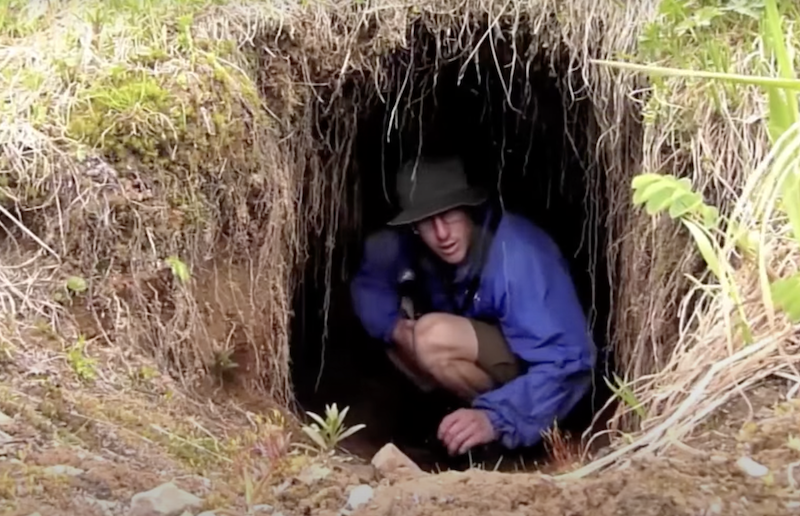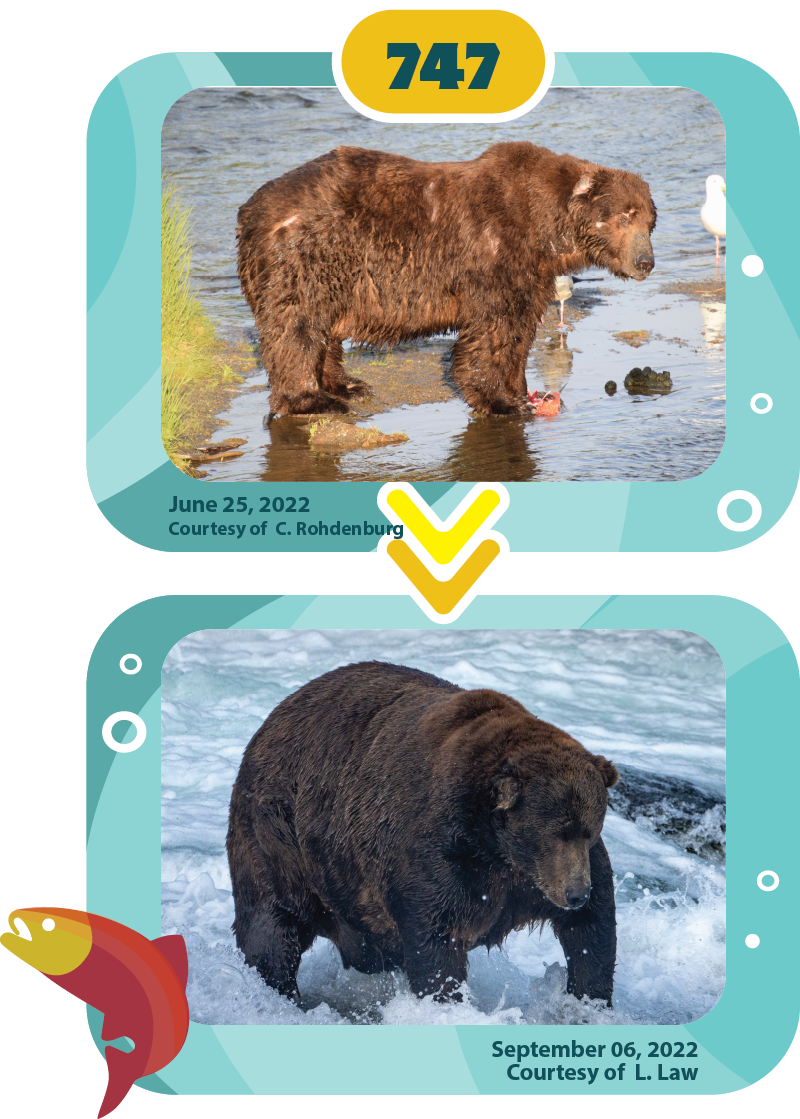
By now, I’m sure you’ve heard of Fat Bear Week — the annual knockout-style competition in which members of the public vote on which bear in an Alaska national park has gained the most weight from summer to fall.
If you haven’t seen it all over your social media, here’s a quick rundown: Every October, this weeklong online contest celebrates the fattest bears at Brooks River in Katmai National Park in southern Alaska. Each year, rangers choose 12 bears for the contest and provide two photos of each animal for the public to judge. The first photo is from mid-July, and the second is from early September, after the bear has bulked up in preparation for winter hibernation. During this time, bears can double their body weight. The public then decides which bear they think has gained the most.
The competition is a knockout tournament, with the bear who receives the most votes advancing to the next round. Any bear who loses gets eliminated. At the end of the week, the bear with the most votes gets crowned champion on Fat Bear Tuesday — which is actually today.
OK, now that you’re up to speed, let’s get into it.
When and how did Fat Bear Week Start?
Since 2012, Katmai National Park’s staff has livestreamed its wildlife online with the help of explore.org, attracting observers from all over the country and the world. Several cameras show the bears in Brooks River and the surrounding areas.
In 2014, Mike Fitz, then a Katmai National Park ranger, noticed a comment on one of the bear livestreams in which a user had posted side-by-side images of the same bear from early summer and late summer, he told BuzzFeed News.
“Something clicked in my head,” said Fitz, who now works with explore.org. “I thought, hey, it would be pretty neat and maybe fun to allow the public to decide who they thought was the fattest and most successful bear of the year, because fat means success for brown bears.”
Fitz hatched a plan with several other park rangers, and they decided to put on a one-day event on the park’s Facebook page in which the public would vote on the fattest bear.
“It was very well received,” Fitz said.
This was the first-ever Fat Bear Tuesday.
At the time, Katmai National Park didn't have a huge social media following, but Fitz noticed that the engagement was super high on Fat Bear Tuesday, so he decided to expand it into a whole week rather than a day. “And that's how Fat Bear Week was born,” he said.
The first Fat Bear Week took place in 2015 on Facebook. In 2020, Fitz, along with rangers from Katmai National Park, decided to begin hosting the event on explore.org’s platform to allow more people to participate.
Since then, the votes have gone up dramatically, Fitz explained.
Last year, the contest saw around 800,000 votes, and this year he is predicting that it will reach a million votes.
“I did not expect Fat Bear Week to become as popular as it has,” the former ranger told BuzzFeed News. “I thought it would just be a quirky thing I did every year, but I did not expect it to be this worldwide event.”

Why is it so popular?
Fitz credits the popularity of Fat Bear Week to the fact it is a “positive story.”
“There’s a lot to be concerned about with the state of the world and humanity,” he said. “Fat Bear Week gives us the opportunity to celebrate an ecosystem that’s working. It’s functioning at its fully realized potential.”
Katmai National Park is home to more than 2,200 brown bears, one of the largest brown bear populations in the world. Brooks River is a unique place, Fitz said.
“If you go to Yellowstone and you see a grizzly bear off in the distance, it’s going to be fun to watch for a while, but you don’t know much about that individual bear’s life history,” Fitz said. “But for many of the bears at Brooks River, we get to watch them grow from cubs into adults and raise their cubs and compete for mates and mature into older bears. It provides this really unique and rare wildlife-watching opportunity.”
For Fitz, the most significant part of Fat Bear Week and the webcam livestreams is the access to nature and national parks that they provide to the public.
“When I started my career as a park ranger, the technology wasn’t available for park staff to reach audiences who weren’t physically in the park,” he said. “Most of the time, people would come to visit in person, so you would give a talk at a visitor center to around 20 people.”
So when Katmai National Park entered into a partnership with explore.org in 2012 and began livestreaming the bears at Brooks River, it changed how Fitz understood the relationship between people and wild landscapes, he said.
“The connections that people are making through the webcams to the bears in Katmai are just as strong as the connections people can make in person,” he said. “I think that's a really remarkable thing.”

Fitz left Katmai National Park a few years ago after his wife, who is also a park ranger, took a job at a different national park in another state, leading them to move across the country. Fitz now works with explore.org as a naturalist, helps run the livestreams, and continues to run Fat Bear Week.
This year, Fitz has been observing the bears just like us — from home.
This year's contest
This year’s Fat Bear Week grand finale is very much a toss-up, Fitz said. Over the last week, 12 bears have been whittled down to two — Bear 901 and Bear 747.
According to the Fat Bear Week website, 747, an adult male bear, has become one of the largest brown bears on Earth, weighing around 1,400 pounds. 747, who was named champion in 2020 and is a skilled hunter, is most often found “in the jacuzzi or near the far pool of Brooks Falls,” the website states.
“747 survives winters really well,” Fitz added. “He often comes out of the den with a lot of additional fat reserves that help to fuel his survival in the springtime when there’s not a lot to eat.”

Fitz has publicly endorsed Bear 747 for many years now, including this year.
“It’s a bit of a running joke for me and some of the hardcore bear cam fans,” he said. “I’ve done that for the past several years, and 747 hasn’t won many. He’s only won one before. So I don’t think my endorsement carries that much weight.”
Why 747? Well, he’s an impressive bear, Fitz said.
“He is the largest bear I've ever seen, he’s always super fat in the fall, and he’s just a great bear to watch ... a tough competitor, one of the more dominant bears at the waterfall.”
Up against Bear 747 is Bear 901, a “medium-small yet quickly growing adult female.” 901 is around 6 years old and is often keen to “defend her fishing spots from other bears,” according to her biography on the website.
“She was courted by several males earlier this summer, so it’s possible she’s pregnant,” Fitz said. “She'll need the fat, not only for her survival during winter hibernation, but she'll give birth in the den if she goes to the den pregnant.”
Despite his bias toward 747, Fitz admitted that he does have a soft spot for 901. “I am very excited to see 901 in the final this year,” he said. “Her transformation has been tremendous this year. I think that has resonated with a lot of people.”

You'll notice on the Fat Bear Week website that some bears have nicknames, and others simply have numbers. Why is this? Well, according to Fitz, every bear in the long-term monitoring study conducted by the National Park Service receives an ID number, and there is no formal nicknaming process.
“Sometimes bears get nicknames; often they don’t,” he said. “In recent years, park staff have refrained from assigning nicknames to newly ID’d bears.”
Fitz writes the bear biographies and profiles for the Fat Bear Week website. Over the years, he has spent time observing them in person and also online via livestreams. When writing their bios, Fitz said he tries to understand what the bear’s summer was like, the challenges they might face to survive the winter, and what “fat means to that individual animal specifically,” he said, “because it’s a different story for each bear.”
In the past, Fat Bear Week winners have included Bear 480 (aka Otis), who was, and still is, a crowd favorite. Otis has won four times (2014, 2016, 2017, and 2021).
One of Fitz’s favorite bears is Bear 435, also known as Holly, who won in 2019. “She looks like a toasted marshmallow,” Fitz said. “She’s just so big and round ... she’s just this cone of fat, a really beautiful animal.”
The Fat Bear Week Scandal
Holly was actually involved in a scandal earlier this week. The Katmai National Park Twitter account announced that she had triumphed over 747 in the semifinal of this year’s competition. But then, one day later, her win was retracted.
“Someone stuffed the ballot box,” explore.org tweeted on Sunday. “The correct total after our review is 747: 37,940, and 435: 30,430. That makes 747 today's winner.”
“It appears someone has decided to spam the Fat Bear Week poll,” the Katmai National Park tweeted. “But fortunately, it is easy for us to tell which votes are fraudulent. We have discarded the fake votes.”
Fortunately, Fitz said, the website engineers looked into the problem and identified which votes were wrongly cast. Explore.org added a captcha to the site to reduce the chances of it happening again.
Takeaways
If you’re wondering whether there are prizes for the bears that win Fat Bear Week, the answer is, sadly, no.
“The bears don’t get anything from Fat Bear Week at all,” Fitz said. “They don’t know what’s going on. This is an imaginary and virtual competition.”
But for Fitz, it’s not about who wins; instead, he sees this as an opportunity to get people thinking and learning about bears and their ecosystems.
“It’s important to think about how bears survive, why they survive, what they need to survive, and also to celebrate the ecosystem at Katmai that supports them,” Fitz said.
